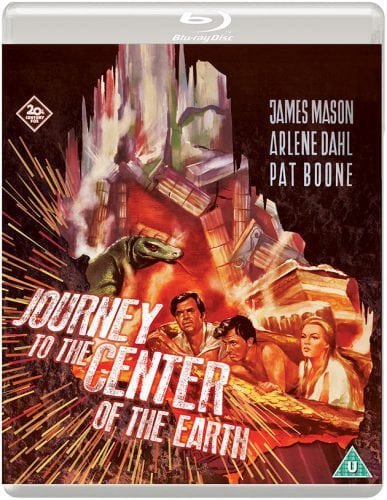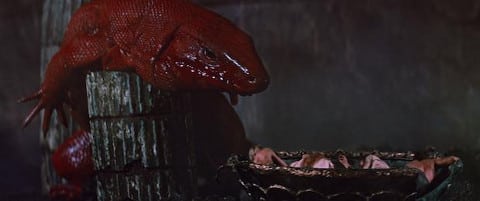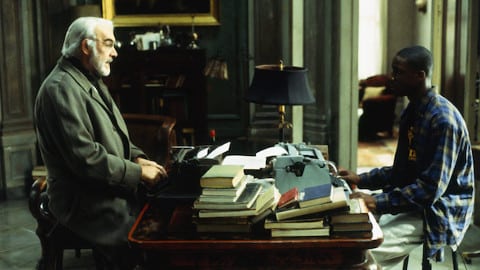Journey To The Centre Of The Earth (1959)
Directed by: Henry Levin
Written by: Charles Brackett, Walter Reisch
Starring: Arlene Dahl, James Mason, Pat Boone, Peter Ronson
USA
AVAILABLE ON DUAL FORMAT BLU-RAY AND DVD; NOW, from EUREKA ENTERTAINMENT
RUNNING TIME: 129 mins
REVIEWED BY: Dr Lenera, Official HCF Critic
Professor Sir Oliver Lindenbrook, a geologist at the University of Edinburgh, is given a piece of volcanic rock by his admiring student Alec McEwan who found it in a shop. Deciding that the rock is unusually heavy, Lindenbrook, mostly thanks to the carelessness of his lab assistant, Mr Paisley, discovers a plumb bob inside bearing a cryptic inscription. It was left by a scientist named Arne Saknussem, who had, almost 300 years earlier, found a passage to the centre of the earth. Lindenbrook contacts Professor Göteborg of Stockholm but Goteberg opts to try to reach the earth’s core first. Lindenbrook and McEwan chase him to Iceland, where they find Goteberg dead in his hotel room. Accompanied by an Icelander Hans Bjelke, his pet duck Gertrude, and Goteberg’s widow Carla, they set off for the mountain from which the route inside the Earth begins, but Goteberg’s killer is also going the same way and is ahead of them…..
I’d reviewed Journey To The Centre Of The Earth a few years back for HCF, but Eureka bringing out the movie on Blu-ray and in a 4k restoration was reason enough to revisit it yet again and do a slightly more extensive review. I’ve seen it a huge amount of times you see, having loved it as a kid and having always enjoyed going back to it even if I do become increasingly aware of its imperfections. It’s a very slow starting adventure which may try the patience of fidgety kids these days who are used to things moving at a lightning pace, but it gets progressively more exciting and fantastical as it progresses and overall remains better than the Brendan Fraser version [though in truth that was more of a sequel than a remake, albeit more of the original book rather than this film version]. The main thing you have to really do whilst watching it is just turn a blind eye to the implausibility of people being able to descend inside a mountain into the bowels of the earth. We all know that nobody would be able to survive ten minutes down there. The Core may be almost as silly but at least gives a better idea of what it would be like inside the earth. Ignoring that, there’s a surprising absence of dirt and dust, and how on earth do they breathe? Best not to think about all this kind of stuff and enjoy the escapism, and remember that Jules Verne, who wrote the book, just didn’t know in 1884 how much his theories would go on to be disproved.
The script by Charles Brackett and Walter Reisch roughly followed Verne’s story but changed many details including the early setting being altered from Germany to Scotland, the opening manuscript becoming a rock containing a plum bob, no sighting of Prehistoric Man and the addition of a villain, two love interests and a duck. I believe that the film still has the essence and feel of Verne’s story, and that’s sometimes more important. In any case, making Alec [changed from Axel] not a whiny wimp was certainly an improvement. Pat Boone didn’t want to make it and only agreed to do the film if he could sing some songs, but two out of three of them were cut out of the final print anyway. Clifton Webb was to be Lindenbrock but feel ill so was replaced by James Mason, while Alexander Scourby did shoot some scenes as Count Saknussemm but was considered unsuitable so was replaced by Thayer David. Mason disliked Arlene Dahl’s movie star preening, their relationship not unlike that of their characters in the film. Many of the underground scenes were shot at Carlsbad Caverns National Park in New Mexico. The picture, the third of three popular Verne adaptations in the 50’s [the other two being 20 000 Leagues Under The Sea and Around The World In 80 Days was a big hit and became a favourite of kids who saw it at the cinema or on TV though it was often heavily cut on TV. I remember seeing it once many years ago and the first twenty or so minutes were removed. This would have sped up the film somewhat but it would not have made much sense!
Yes, though Journey To The Centre Of The Earth opens with an image of the earth and the viewer gradually going inside it as Bernard Herrmann’s typically astute main title music goes deeper and deeper until hitting rock bottom, our explorers don’t even begin their descent until around fourty-five minutes have passed. The film really does take an inordinate time to get going and they could have probably condensed this section greatly though there’s still a great deal to enjoy. I could have done without some romantic dueting on a piano, but most entertaining is Lindenbrook’s obsession with finding the source of this rock and getting a reply from Professor Göteborg preventing him from sleeping, eating or drinking, a bit of a murder mystery, and a really pointless but funny bit where McEwan and Lindenbrook are imprisoned in a cellar where they think another prisoner is trying to make contact with them – but it’s really just a duck. Our villain Saknussem gets a great intro where his face looms out of total darkness. On the other hand Carla doesn’t really seem very distraught at her husband’s death, though having her come along on the journey [she has nothing to lose] actually does benefit the film, it being a classic case of two people of the opposite sex who detest each other [he especially when she proves to be right about some things, like hearing footsteps] yet who we know will end up feeling somewhat differently. Co-writer Charles Brackett was Billy Wilder’s co-writer for much of the first half of his career so some of their dialogue has the bite you expect from films like Sunset Boulevard. There’s also a very good little scene where McKewan tells Carla in a roundabout way that he has developed an infatuation for her and she rebuffs him in the best possible way.
Once they all begin their descent the film really does begin to thrill and rarely lets up, with even the bringing along of the duck not really resulting in the Disney-style cutsiness you may expect. Honestly, if you can get yours kids through the first third then they will love the rest. There’s a real sense of adventure and a terrific feeling of wonder while the film throws in as many incidents as it can, as the group encountering floods, falling rocks [including one Indiana Jones might think looks familiar], quicksand, a grotto full of diamonds, tremors, seperation, a field of giant mushrooms, prehistoric monsters, a sea which actually is the centre of the earth, and Atlantis! By the time the group are in a huge bowl being pushed up towards the earth’s surface by lava towards the top of Mt Etna [a sequence which looks okay but disappointingly omits what would have been its best shot], the event seems rather normal and you feel that anything’s possible. The tone is just right – there are lighter moments and the film seems to know that it’s all rather ridiculous but still treats the overall story with respect, the result being something which adults should be able to get as much out of as kids. Apart from one glaring plot hole which I even noticed as a child [I won’t mention it but it concerns a certain skeleton], the storytelling is by and large fine – there’s only one odd stumble where McEwan’s girl back home Jenny seems to dream the group approaching the centre of the earth before we cut back to everyone washed up on a beach. On the other hand there’s a surprising [but believable] death which rather upset me as a kid and which you probably wouldn’t get if the film were made today.
The generally convincing sets avoid the artificial look you often get and along with some terrific matte paintings combine well with the real cavern locations. Maybe the artifice is overly obvious to some modern eyes, but us older film watchers think that CGI often sticks out just as much. There are only two scenes with monsters, and the second is a little too brief, but the first, where a herd of Dimetrodons [giant lizard-like creatures with fins on their backs] attacks our protagonists, is very well achieved despite the fact that they decided to avoid stop-motion [this movie is good, but just imagine how it would have been even better with some Ray Harryhausen-style magic] and go for the less time-consuming option of using real lizards. The use of slowed-down filming, very good matte work, interesting angles [a shot from inside a lizard’s mouth!] and animals who actually look like the creatures they’re supposed to be representing [as opposed to, say, an iguana in the 1960 version of The Lost World being called a Brontosaurus] makes the sequence really work. Sadly, it really does look like lizards were harmed and killed in this movie, with one being drowned in outmeal subtituting for lava and another having sharp implements hit it, drawing blood, and then being eaten by the others. It’s been said by some, including one person who worked on the film, that no lizards were actually harmed at all and it was all accomplished to the use of things like missing frames and reverse photography. I’m not convinced, but thankfully these moments are only a small part of the film.
Director Henry Levin was really just a solid craftsman but he handles this kind of thing very well and it’s a surprise that he didn’t go on to do more films of this type. The Edinburgh scenes don’t entirely work because none of the main cast attempt to sound Scottish, but the performers are all good except for the rather wooden Boone, with Mason as great to watch as usual. He tackles his part with depth even as he’s clearly having fun as well, and because it’s Mason you like this guy even when he’s throwing tantrums and being very rude to others. His child-like beam at new discoveries is wonderful. One of the biggest contributions to the atmosphere of Journey To The Centre Of The Earth is made by Herrmann’s score, which employed five organs, no strings except for some moments near the beginning, and mostly instruments played in the lower registers to give a feeling of being way below the earth’s surface. It’s hardly a tuneful score, consisting mostly of simple chord patterns including that usual Herrmann two note progression, but it gives the proceedings real gravitas. A few niggles aside, Journey To The Centre Of The Earth is within shouting distance of being one of the all time great movies of its type. I think that what draws me back to it more than anything else is its wonderful, inspiring spirit of adventure which appealed to me so much as kid, encapsulated perfectly in the final scene where Lindebrook tells a huge audience to go out and make their future and if they want, to carry on where he left off. You don’t get many movies with such uplifting messages for the younger generation these days.
Having owned this on DVD for some time, I can tell you that comparing it with the Blu-ray restoration is like comparing DVD and video. Aside from the perhaps expected improvements in depth and sharpness, the colours are far warmer and it really is almost like seeing for the first film. I should also mention the sound. Because I have an extremely limited audio set-up, I’m not a good person to judge this kind of thing, but even I could tell how much richer and deeper the sound for this Blu-ray is, especially the score and the climax. They’ve done a great job of remixing the sound so it’s more modern-sounding without compromising the original audio design.
Twilight Time’s Region ‘A’ release only had the audio commentary and the isolated score and sound effect tracks as special feature and it’s replicated here in the ‘audio options’ section. It’s a typically relaxed Twilight Time chat, Nick Redman here joined by writer Steven C. Smith [author of a book on Herrmann] and Diane Baker, the only surviving member of the cast though she’s not in the film much. There’s a bit of back slapping, with Redman telling Smith he’s written the best book ever on a movie composer, and both guys grovelling to Baker. There’s not much ‘making of’ information either, and they do go and on about Mason, but there’s still lots to interest, such as Baker’s reminisces [not all related to this film]. The audio track is worth a listen if you don’t own the CD soundtrack. Eureka have added a 22 minute talk from Kim Newman about the film. He’s always great to listen to, covers most things, and is especially good on the problems with adapting Verne and how Mason refuses to eat Boone alive despite being an immeasurably superior actor. The restoration featurette was on some of the DVDs. I do think that this film could do with one of those extensive ‘making of’ documentaries, but this release is still very much worth the upgrade, and if you don’t own it then why not give it a go? It’s probably just as good and definitely more exciting than the better known Verne adaptations of 20 000 Leagues Under The Sea and Around The World In 80 Days.
SPECIAL FEATURES:
*1080p presentation from a definitive 4K restoration
*Optional stereo PCM soundtrack and 5.1 DTS-HD Master Audio options
*Isolated music and effects track
*Optional English subtitles for the deaf and hard of hearing
*Audio Commentary with Actress Diane Baker and Film Historians Steven C. Smith & Nick Redman
*New video interview with critic and author Kim Newman
*Featurette on the film s restoration
*Original theatrical trailer
PLUS: A booklet featuring an original review of the film from 1959; a poster gallery; and a selection of rare archival imagery










Be the first to comment